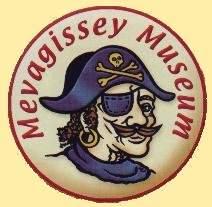
East Wharf, Inner Harbour,
Mevagissey, PL26 6QR
Tel: (01726) 843568
Email: info@mevagisseymuseum.com
Web: www.mevagisseymuseum.co.uk
History of a town
History's first mention of Mevagissey is in 1313, but its fine, harbour-side museum suggests it is much older. Older even than the two 6th century Irish missionaries who gave it its name, or the archaeologically attested trade with Phoenicians in copper and tin.
Three artefacts in the Museum rubbing stone, an arrow and axe-head - put the original settlement back at least as far as the Bronze Age. Then, Mevagissey Man would have hunted land-based animals to survive, but for most of the village's varied history the hunting has been of fish - and contraband.
A museum piece itself, the building in which the exhibits are housed dates back to 1745 when it was used to construct and repair vessels for smuggling. Most of the roof supports are spars from old revenue-dodgers, refitted or broken up: the tools on display and the lathe upstairs, with its huge hand-turned wheel, built their replacements.
Sometimes, the smugglers were caught and locked up in the village "clink". The manacles and massive iron clad door on display suggest escape was rare. Elsewhere in the Museum, a kinder, wider picture emerges of life in Mevagissey down the ages. An Apple Crusher and Cider Press, their vast granite interfaces still in perfect condition; an original horse drawn, rotating Barley Thresher, and a perfectly detailed Cornish Kitchen with a working cloam oven.
But even in this more normal, law-abiding context, there is uncertainty and heartbreak. On display is a promissory note from Ball's Bank of Mevagissey, which was issued in October 1824 - a week before the bank folded. Hard times, high times, all times are on show at Mevagissey Museum.
The museum is situated on the north side of the harbour.
Opening TimesDaily, 11.00am - 5.00pm Admission Charged |
Mevagissey Smuggling in Cornwall Mevagissey Model Railway Mevagissey Aquarium